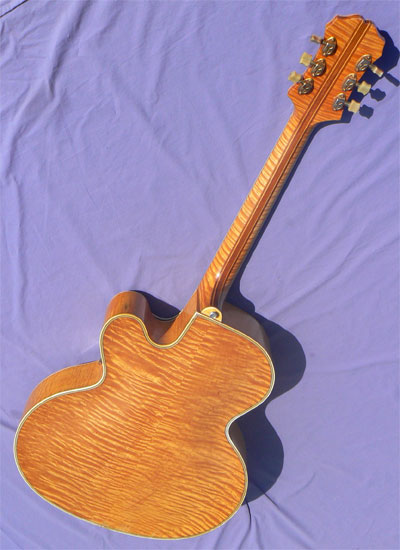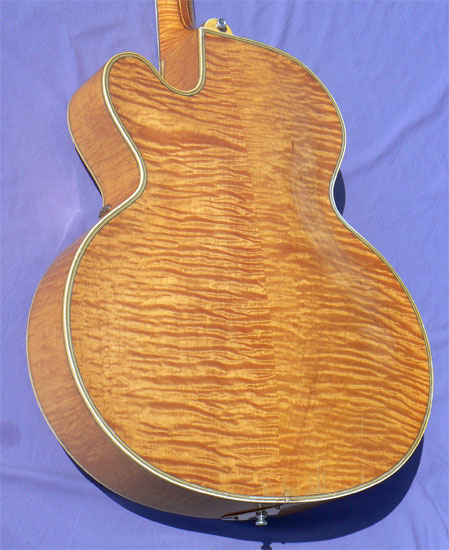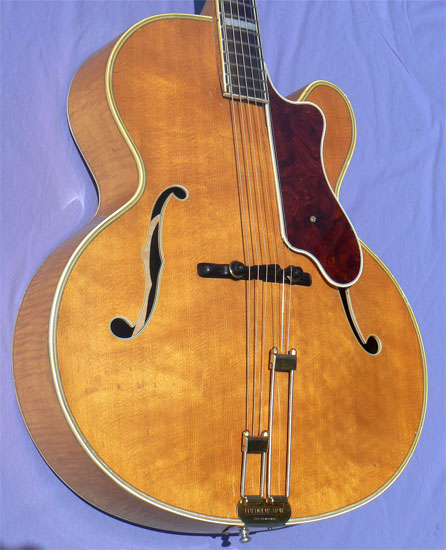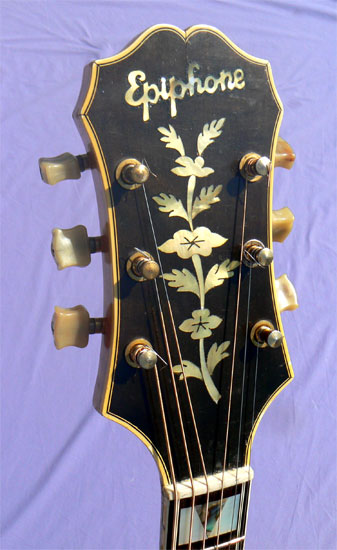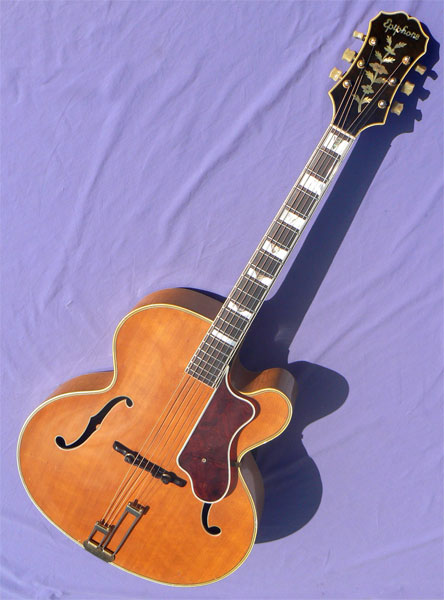
Home / Instruments /Accessories / Ordering / Tips
archtop.com
1951 Epiphone Emperor Regent
Status: Pricing and hold status for all instruments currently available is shown on our Instruments page here. If this instrument does not appear on the Instruments page it has been sold, and is no longer available. Photos and descriptions of Previously Sold instruments may be found here. To be notified of examples of this model or similar instruments in the future, please contact [email protected],. Please be specific on which instrument(s) you're looking for, and we'll be happy to contact you as soon as they become available.
Serial #: 63137 Body size at lower bout: 18 1/2" Scale length: 25 1/2" Nut: 1 11/16" Neck depth, 1st/10th frets: .93/1.03
Materials: Solid hand graduated AAAA curly maple back, neck and sides; solid hand graduated spruce top; 9-piece maple-walnut neck; 9-ply body binding; triple-bound heel cap, neck binding, f-holes and head stock; solid Brazilian rosewood fingerboard with "split-block" mother of pearl and abalone inlay; MOP tree-of-life peghead inlay in stained holly headstock veneer.
Hardware: All original gold hardware includes Pat. Pend. Frequensator tailpiece, epsilon-logo 16X1 tuners, multi-bound tortoise pickguard, adjustable compensated Brazilian rosewood bridge, hex-key adjustable truss rod.
Notes: The glory of the Epiphone line, the Emperor was introduced in 1935 as the largest and most costly instrument the company ever made. Epiphone produced several prototype cutaway examples as early as 1941, but for reasons unknown, dawdled until 1949 to add them to the regular catalog, a full decade after Gibson started offering the cutaway Super 400.
The Emperor Regent (or "Cutaway") model, had a run of just five years until the last known example was crafted in 1954. As a consequence, the Emperor Regent remains one of the rarest and most desirable guitars of the classic era. With its massive 18 1/2" lower bout, this mammoth guitar was the largest production archtop of its time. Though bigger even than the mighty Super 400, the Emperor is paradoxically more comfortable to hold, as the upper bout is a full inch smaller than its Gibson counterpart. In addition, the extended Emperor cutaway offers several frets more access in the uppermost register than the S-400.
Premium priced over sunburst examples, the cutaway Emperor in natural finish was the most expensive offering in the Epi catalog. Not to mention the most spectacular, as the most vividly figured tonewood was generally reserved for the blonde guitars, which showcase it to greatest advantage. This outstanding example is crafted of AAAA curly maple in the back, sides and neck, with flame figure of spectacular intensity.
Showing no cracks or structural repairs, the guitar remains fitted with all its original hardware, including the epsilon-logo 16:1 tuners, and Pat. Pend Frequensator tailpiece, compensated adjustable Brazilian rosewood bridge, and multi-bound tortoise pickguard. The original blonde finish has ambered to a deep golden hue, and is notably free of thumb or buckle wear, with playwear confined to some scattered lacquer nicks on top. Epiphone lacquer finishes of this era can be remarkably resistant to checking, and this handsome guitar is no exception.
The extravagant multi-ply binding is original and tight to the body, and the neck angle and bridge height are both excellent, with room to adjust the action up or down. The traditional C profile neck has a solid, gentle feel, with smooth low action over a fresh, high-precision setup. The soundboard is hand-graduated from solid quarter-sawn bookmatched spruce, parallel braced to optimize for power and dynamic range. With exceptional projection, the voice is warm and vibrant, throughout the register. Clear and balanced, the instrument has a voice only decades of aged tonewood can convey.
A special plus, the guitar is supplied with an additional pickguard, with an Armstrong floating Johnny Smith pickup and volume control attached. And all contained in its immaculate original plush lined hardshell case.
An exceptional find, this stunning instrument sounds every bit as impressive as it looks. One only, call now.
Setup: Trussrod tension and neck relief adjusted; bridge height adjusted; bridge compensation set; string slots at nut and bridge inspected and recut as necessary; bridge foot contour inspected and fit to top as necessary; bridge radius inspected and recurved as necessary; bridge wheels and tuners lubricated; fingerboard and bridge oiled; body and neck cleaned and hand polished.
